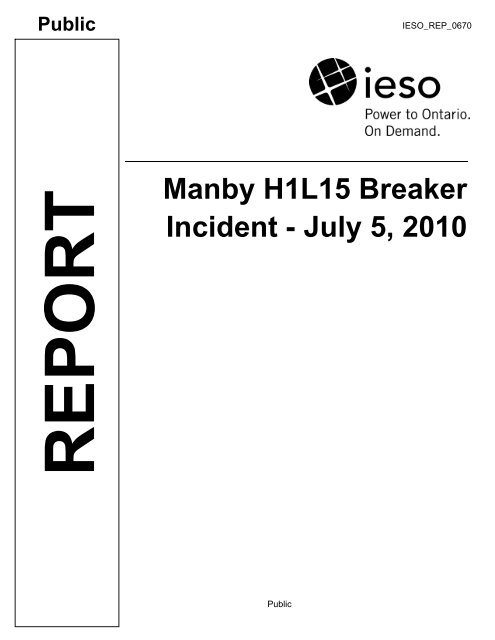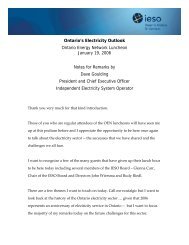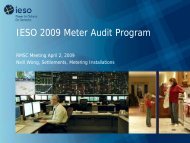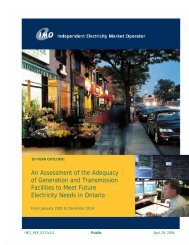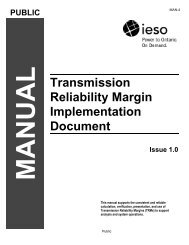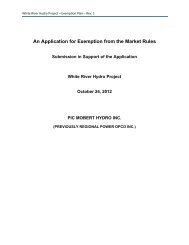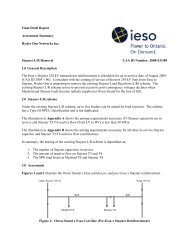Manby H1L15 Breaker Incident - July 5, 2010 - IESO
Manby H1L15 Breaker Incident - July 5, 2010 - IESO
Manby H1L15 Breaker Incident - July 5, 2010 - IESO
You also want an ePaper? Increase the reach of your titles
YUMPU automatically turns print PDFs into web optimized ePapers that Google loves.
<strong>IESO</strong>_REP_0670Document IDIES_REP_0670Document Name <strong>Manby</strong> <strong>H1L15</strong> <strong>Breaker</strong> <strong>Incident</strong> - <strong>July</strong> 5, <strong>2010</strong>Issue Issue 1.0Reason for IssueFinal release.Effective Date October 20, <strong>2010</strong>© 2000, Independent Electricity System Operator.
<strong>Manby</strong> <strong>H1L15</strong> <strong>Breaker</strong> <strong>Incident</strong> – <strong>July</strong> 5, <strong>2010</strong>List of FiguresDocument Change HistoryIssue Reason for Issue Date1.0 Final release October 20, <strong>2010</strong>Related DocumentsDocument IDDocument TitleOctober 20, <strong>2010</strong> Public 1
List of Figures<strong>IESO</strong>_REP_0670Table of ContentsTable of Contents ....................................................................................................... 2List of Figures ............................................................................................................. 3Table of Changes ....................................................................................................... 41. Synopsis ............................................................................................................. 52. Background ......................................................................................................... 63. Description of the Event ...................................................................................... 74. Sequence of Events ............................................................................................ 95. System Impact .................................................................................................. 125.1 Impact on Bulk Electricity System (BES) Reliability ............................... 125.2 Impact on Tie Lines ................................................................................ 135.3 Impact on Load & Voltages .................................................................... 135.4 Impact on Generation............................................................................. 156. Conclusions ...................................................................................................... 166.1 Preliminary Investigations by Hydro One ............................................... 166.2 Actions to Date ....................................................................................... 172 Public Issue 1.0 – October 20, <strong>2010</strong>
<strong>Manby</strong> <strong>H1L15</strong> <strong>Breaker</strong> <strong>Incident</strong> – <strong>July</strong> 5, <strong>2010</strong>List of FiguresList of FiguresFigure 1 <strong>Manby</strong> West Station ..................................................................................... 6Figure 2 <strong>Manby</strong> East Station ...................................................................................... 6Figure 3 GTA 115 kV System .................................................................................... 8Figure 4 Frequency Trends – <strong>July</strong> 5 th , <strong>2010</strong> ............................................................ 12Figure 5 Ontario to Michigan and New York Tie-Line Flows – <strong>July</strong> 5 th , <strong>2010</strong> .......... 13Figure 6 Richview Switching Station 230 kV Voltage – <strong>July</strong> 5 th , <strong>2010</strong> .................... 14Figure 7 Percentage of Manual Load Restoration – <strong>July</strong> 5 th , <strong>2010</strong> ......................... 14Figure 8 <strong>Manby</strong> East and West Station Layout with Fault Order & Location ............ 16October 20, <strong>2010</strong> Public 3
Table of Changes<strong>IESO</strong>_REP_0670Table of ChangesReference(Section andParagraph)Description of Change4 Public Issue 1.0 – October 20, <strong>2010</strong>
<strong>Manby</strong> <strong>H1L15</strong> <strong>Breaker</strong> <strong>Incident</strong> - <strong>July</strong> 5, <strong>2010</strong>1. Synopsis1. Synopsis♦ Extreme Event (Category D) 1 : a phase-to-ground fault causing a 230 kV breaker tofail explosively, triggering five subsequent faults and removing an entire 230 to 115kV transformer station from service.♦ Duration: 3.6 seconds from the beginning of the first fault to the end of the last.Clearance times ranged from 64 to 89 milliseconds while fault magnitudes rangedfrom 22 to 42 kilo-amps (kA).♦ Root Cause: internal failure of the breaker♦ Impact on Generation: no generation loss was linked to the event, however severalgenerating stations reported noticeable swings to their terminal voltages in responseto the faults.♦ Impact on Load: approximately 1550 MW of load was interrupted, 902 MW ofwhich was removed from service by configuration. The remaining 648 MW wastriggered by the operation of customer-owned under-voltage protection withinsurrounding local distribution centres.♦ Impact on Tie lines: Michigan and New York experienced flow increases of 725MW and 690 MW from Ontario respectively. Flows were well within interfacecapabilities and were restored to pre-contingency levels within 12 minutes.♦ Impact on other Reliability Coordinator Areas: MISO and NYISO reported noadverse impact to their systems.- End of Section -1 As defined by NERC Standard TPL-004-0: an extreme event resulting in two or more (multiple) elementsremoved or cascading out of service.October 20, <strong>2010</strong> Public 5
2 Background <strong>IESO</strong>_REP_06702. BackgroundThe <strong>Manby</strong> 230 kV to 115 kV Transformer Station (TS) is a Hydro One owned facilityresponsible for serving load customers in the cities of Oakville, Mississauga, and downtownToronto. The station is comprised of a west and east yard located within the same stationfootprint, but electrically separated from one another. Each yard is equipped with 3 – 230 to115 kV autotransformers, multiple 115 kV and 230 kV breakers, the majority of which areoil-filled, several customer load transformers, and a 336 MVAR rated 230 kV capacitor.Figure 1 <strong>Manby</strong> West StationFigure 2 <strong>Manby</strong> East Station- End of Section –6 Public Issue 1.0 – October 20, <strong>2010</strong>
<strong>Manby</strong> <strong>H1L15</strong> <strong>Breaker</strong> <strong>Incident</strong> - <strong>July</strong> 5, <strong>2010</strong>3. Description of the Event3. Description of the EventAt approximately 15:40 Eastern Standard Time (EST) on <strong>July</strong> 5, <strong>2010</strong> the <strong>Manby</strong> West<strong>H1L15</strong> oil-filled breaker suffered an explosive internal failure, spreading debris and oil over150 feet in diameter and causing the breaker to catch fire. Oil spray and debris from thebreaker was attributed to subsequent faults on several connected transmission lines and busbarsections in the <strong>Manby</strong> East and West yards, resulting in a total load interruption of over1550 MW and affecting over 240,000 people in the Greater Toronto Area (GTA). Of the1550 MW that was automatically removed from service (ARFS), 902 MW were removed byconfiguration while the remaining 648 MW were in response to the fault surge as a result ofcustomer-owned, low-voltage protection operation within surrounding local distributioncentres.There was no adverse weather occurring in the GTA at the time of the incident. All areavoltages and thermal ratings were being respected under normal operating conditions. Withthe exception of a forced outage to a <strong>Manby</strong> East 230 kV capacitor, there were no otherongoing outages in either of the <strong>Manby</strong> yards.At 15:40:35 EST 230 kV circuit R15K (Richview – <strong>Manby</strong> West) and the <strong>Manby</strong> H1 buswere ARFS following normal line and bus protections as a result of the phase-to-ground faulton the <strong>Manby</strong> West <strong>H1L15</strong> breaker. Over the course of approximately 3.6 seconds, fiveadditional faults removed the <strong>Manby</strong> West A1 bus, K23C, <strong>Manby</strong> East H2 Bus, R1K, and the<strong>Manby</strong> East A2 bus from service upon receipt of normal bus and line protections.The resulting load loss caused the <strong>IESO</strong> Area Control Error (ACE) to increase to a positive1580 MW. In addition, multiple 230 and 500 kV stations in Southern Ontario saw busvoltages rise as the need for reactive support was diminished by the loss of load. <strong>IESO</strong>operators took immediate action in manually dispatching generation and reactive resources toreduce ACE and system voltages back to pre-contingency levels. MISO and NYISO sawincreases of 725 MW and 690 MW into their systems on the Michigan and New Yorkinterfaces respectively. System voltages were restored to normal within ten minutes. Withintwelve minutes, intertie flows were back on schedule as ACE was reduced to 0 MW.Load restoration efforts began immediately after system conditions were deemed acceptable.As Hydro One required visual inspection of the faulted equipment prior to making itavailable for use, load transfers were conducted in order to re-supply the GTA load fromalternate sources that were unaffected by the incident. This transfer capability can be seen inFigure 3 on the following page. With the exception of one load distribution station andseveral feeders at another, all load removed by the contingency was restored through loadtransfers in under two hours from the time the incident occurred.Load transfers were expedited by utilizing spare capacity from generating units at thePortlands Energy Centre. At the time of the fault, Portlands was in-service generatingapproximately 75% of its rated capacity. Once load transfers commenced, <strong>IESO</strong> manuallyOctober 20, <strong>2010</strong> Public 7
3 Description of the Event <strong>IESO</strong>_REP_0670dispatched the facility to increase output as required. In the absence of Portlands generation,load restoration would have been limited by post-thermal restrictions on the Leaside 230 to115 kV autotransformers.Figure 3 GTA 115 kV SystemBy 19:15 EST all the load that was removed by the contingency was restored. All loadtransfers were reversed by 21:23 EST, returning the <strong>Manby</strong> East and West systems to normalconfiguration. All <strong>Manby</strong> equipment was returned to service with the exception of the<strong>Manby</strong> <strong>H1L15</strong>, L15L22, and A1L22 – 230 kV breakers. Two of the three breakers were leftdamaged while the A1L22 was declared unavailable as it shares the same DC supply as theother two damaged breakers.- End of Section –8 Public Issue 1.0 – October 20, <strong>2010</strong>
<strong>Manby</strong> <strong>H1L15</strong> <strong>Breaker</strong> <strong>Incident</strong> - <strong>July</strong> 5, <strong>2010</strong>4. Sequence of Events4. Sequence of EventsTimeSummary230 kV circuit R15K (Richview – <strong>Manby</strong> West) and the <strong>Manby</strong> West H1bus were ARFS by A & B normal line and bus differential protectionsfollowing a phase-to-ground fault on the <strong>Manby</strong> West <strong>H1L15</strong> breaker.At t+1.37s, a phase-to-ground fault removed the <strong>Manby</strong> West A1 bus fromservice following A & B bus differential protection. With both <strong>Manby</strong>West busses out-of-service, a load interruption of 523 MW was observedby configuration at the <strong>Manby</strong> West, Strachan, and John stations.15:40(t = 0s)At t+1.48s, a 3-phase-to-ground fault occurred on 230 kV circuit K23C(<strong>Manby</strong> East – Cooksville) followed by a phase-to-ground fault on the<strong>Manby</strong> East H2 bus at t+1.92s. The faults were cleared by K23C A & Bline protections and the <strong>Manby</strong> East H2 bus differential protection. Thesetwo events did not trigger any load loss by configuration.At t+2.83s and 3.56s, 230 kV circuit R1K (Richview – <strong>Manby</strong> East) andthe <strong>Manby</strong> East A2 bus both suffered phase-to-ground faults and wereARFS by A & B line and bus differential protections, respectively.Consequently 369 MW of load that was connected the <strong>Manby</strong> East,Wiltshire, Runnymede, and Fairbank stations were also removed fromservice by configuration.A total 902 MW of load was lost by configuration. Another 648 MW ofload was removed from service by voltage sensitive customer-ownedprotection operations responding to the faults.15:4115:42The Ontario Area Control Error (ACE) reached +1580 MW as a result ofthe load loss caused by the contingency. The <strong>IESO</strong> responded to the ACEdeviation by manually dispatching hydro-electric and coal-fired generationto reduce 592 MW and 690 MW respectively, for a total reduction of 1282MW. The remaining 307 MW of over-generation was automaticallyreduced by <strong>IESO</strong> dispatch software once the reduced Ontario demand wasaccounted for. ACE recovered to 0 MW within 12 minutes.The reduction in Ontario demand caused several bus voltages to increaseacross Southern Ontario. <strong>IESO</strong> operators took immediate action to reducethese voltages to acceptable levels by re-dispatching both static anddynamic reactive resources as required. Voltages were restored to precontingencylevels by 15:48 EST.October 20, <strong>2010</strong> Public 9
4 Sequence of Events <strong>IESO</strong>_REP_0670Time15:4615:5716:12SummaryLoad restoration efforts began by opening all off-potential breakers in the<strong>Manby</strong> East and West yards, disconnecting both from the rest of thesystem. With Hydro One declaring all out-of-service equipmentunavailable at <strong>Manby</strong> until an inspection could be made, load restorationcommenced from Leaside TS via the Leaside – Wiltshire corridor, analternate supply point for loads normally supplied from <strong>Manby</strong>.The following Reliability Coordinator Information System (RCIS)message was issued by the <strong>IESO</strong>: “A major system contingency hasoccurred resulting in approx 1500 MW of load loss in the GTA. <strong>IESO</strong> isworking on restoration of this event.”With a return-to-service time for the <strong>Manby</strong> West yard unavailable,switching arrangements began to allow for the John and Strachan loads tobe alternatively supplied from the Hearn switching station (SS) via 115 kVcircuit H2JK (Hearn – John – <strong>Manby</strong>).16:19 60 MW of load was restored at Runnymede16:2316:2816:3016:4617:2240 MW of load was restored at Fairbank. As a result of the loadrestoration, the Leaside – Wiltshire corridor was becoming thermallyrestricted. Load restoration was ceased at the stations until thermalconditions improved.Hydro One declared the <strong>Manby</strong> East H2 bus available for service. Whiledirecting switching to place the bus on potential from the R1K circuit, the<strong>Manby</strong> East L1L23 230 kV breaker received a low air alarm, making itunavailable. The H2 bus restoration would be delayed until an alternatepath could be determined.With the expectation of re-supplying the interrupted load from the Leasideend of the GTA, Portlands generating station (GS) was directed to increaseoutput in order to alleviate post-contingency thermal limits on the 230-to-115 kV Leaside autotransformers.39 MW of load restored at Strachan from Hearn SS via H2JK. Due toH2JK thermal restrictions, Esplanade T11 was disconnected from thecircuit to allow for more load to be restored at Strachan. Another 37 MWof load was restored at Strachan by 17:14.<strong>Manby</strong> East H2 bus and T8 on potential restoring station service. Thisswitching also allowed the <strong>Manby</strong> East station service and T5 distributiontransformer to be placed back in-service, restoring 65 MW of load.17:24 Remaining load at Runnymede restored.17:3717:45Hydro One declared all equipment in the <strong>Manby</strong> East 115 kV yardavailable for service with the exception of the T9 230-to-115 kV autotransformerand 115 kV D bus. As a result, the Fairbank, Wiltshire, andRunnymede distribution stations could be transferred back from Leaside to<strong>Manby</strong> East supply.150 MW of load restored at John after switching was completed to allowthe station to be supplied from Leaside TS and Hearn SS. With theincrease in load, Portlands GS was directed to provide additional reactivesupport to improve area voltages.10 Public Issue 1.0 – October 20, <strong>2010</strong>
<strong>Manby</strong> <strong>H1L15</strong> <strong>Breaker</strong> <strong>Incident</strong> - <strong>July</strong> 5, <strong>2010</strong>4. Sequence of EventsTimeSummaryFairbank, Wiltshire, and Runnymede switched back from Leaside to17:48 <strong>Manby</strong> East supply. Hydro One and Toronto Hydro were given permissionto restore the remaining load at Wiltshire and Fairbank.The <strong>Manby</strong> East T9 230-to-115 kV transformer and 115 kV D bus were18:04 place in-service after being declared available. As a result, all <strong>Manby</strong> East115 kV equipment has been restored to service.18:11 R13K (Richview – <strong>Manby</strong> East) 230 kV circuit placed back in-serviceAll <strong>Manby</strong> West 230 and 115 kV equipment declared available for service18:24 with the exception of the R15K 230 kV circuit terminal breakers, one ofwhich being the <strong>H1L15</strong> breaker that failed explosively.18:45 All load supplied from the <strong>Manby</strong> East yard has been restored.All load supplied from the <strong>Manby</strong> West yard has been restored with the18:52 exception of a low-tension Toronto Hydro feeder due to an equipmentissue. This load was restored at 19:15 after repairs were made.Strachan and John stations transferred back from Leaside and Hearn to21:23<strong>Manby</strong> West supply.- End of Section -October 20, <strong>2010</strong> Public 11
5 System Impact <strong>IESO</strong>_REP_06705. System Impact5.1 Impact on Bulk Electricity System (BES) ReliabilityThe interconnected system remained stable following subsequent faults at <strong>Manby</strong>. As seenin the figure below, each fault was cleared within 90 milliseconds while oscillations weredamped within 250 milliseconds. The most severe fault occurred approximately 1.5 secondsafter the <strong>Manby</strong> <strong>H1L15</strong> failed explosively. This was the result of a 3-phase fault on 230 kVcircuit K23C (<strong>Manby</strong> East – Cooksville).The frequency trend illustrated below is measured locally at the Claireville 500 to 230 kVtransformer station and is a function of how disturbance recorder equipment calculatesfrequency. The fault and switching actions distort the local voltage waveform, and willappear as frequency spikes at local recorders. It is displayed below for the purpose of easilyindentifying the timing and relative severity of each fault. The actual or globalinterconnection frequency remained very stable throughout the event, experiencing adeviation of less than 0.04 Hz once the load loss was realized.Figure 4 Frequency Trends – <strong>July</strong> 5 th , <strong>2010</strong>12 Public Issue 1.0 – October 20, <strong>2010</strong>
<strong>Manby</strong> <strong>H1L15</strong> <strong>Breaker</strong> <strong>Incident</strong> - <strong>July</strong> 5, <strong>2010</strong>5. System Impact5.2 Impact on Tie LinesThe Michigan and New York tie-lines saw an increase of 725 MW and 690 MW out ofOntario respectively. Flows were restored to pre-contingency levels within 12 minutesfollowing <strong>IESO</strong> operator efforts made to reduce ACE to 0 MW. No adverse impact wasreported by the <strong>IESO</strong>’s neighboring reliability coordinators.Eastern Standard Time (seconds)Figure 5 Ontario to Michigan and New York Tie-Line Flows – <strong>July</strong> 5 th , <strong>2010</strong>5.3 Impact on Load & VoltagesApproximately 1550 MW of load was interrupted as a result of the multiple fault occurrencesat the <strong>Manby</strong> West and East yards. Ontario demand dropped from 24,509 MW to 22,915MW causing voltages to rise at multiple 230 and 500 kV stations in Southern Ontario as theneed for reactive support was diminished by the loss of load. Voltages were quickly reducedto pre-contingency levels through the re-dispatch of both static and dynamic reactiveresources. The voltage profile at the Richview 230 kV switching station, locatedapproximately seven kilometers from <strong>Manby</strong>, shows this response in the following figure.October 20, <strong>2010</strong> Public 13
5 System Impact <strong>IESO</strong>_REP_0670Eastern Standard Time (seconds)Figure 6 Richview Switching Station 230 kV Voltage – <strong>July</strong> 5 th , <strong>2010</strong>Of the 1550 MW of load removed from service during the incident, 648 MW were removedby voltage sensitive customer-owned protection operating in response to the faults. Thisresponse, which has seen an increase in magnitude year-over-year, is believed to beattributed to the installation and operation of highly sensitive breakers within residentialhomes. As a result, an increase in sympathetic load loss can be expected to continue with theexpansion of new-home construction.Figure 7 below illustrates how the remaining 902 MW of load removed by configuration wasmanually restored following the breaker explosion. Total load restoration was completed injust over three and a half hours.Eastern Standard Time (seconds)Figure 7 Percentage of Manual Load Restoration – <strong>July</strong> 5 th , <strong>2010</strong>14 Public Issue 1.0 – October 20, <strong>2010</strong>
<strong>Manby</strong> <strong>H1L15</strong> <strong>Breaker</strong> <strong>Incident</strong> - <strong>July</strong> 5, <strong>2010</strong>5. System Impact5.4 Impact on GenerationOntario Power Generation and Bruce Power both reported terminal voltage swings at thePickering and Bruce nuclear generating stations, respectively. All units remained stablefollowing each fault experienced at <strong>Manby</strong>.In order for ACE return to normal, a combination of hydro-electric and coal-fired generatorswere verbally dispatched down at 15:41 EST to compensate for the temporary load loss. By16:00 EST, <strong>IESO</strong> software was re-configured to account for the load profile change and allgenerators were returned to automated dispatch.As discussed earlier, the availability of the Portlands Energy Centre allowed for an expeditedload restoration once load transfers were initiated from <strong>Manby</strong> to Leaside supply. More loadwas available for transfer as the Leaside 230 to 115 kV autotransformers were not asthermally restrictive as they would have been if Portlands was unavailable.- End of Section -October 20, <strong>2010</strong> Public 15
<strong>IESO</strong>_REP_06706. Conclusions6.1 Preliminary Investigations by Hydro OneThe fault originated internally on the <strong>Manby</strong> West 230 kV <strong>H1L15</strong> breaker. Each subsequentfault that occurred on several <strong>Manby</strong> busses and emanating 230 kV circuits are believed to bethe result of the oil and parts that were shot from the breaker once it exploded. It is believedthat the oil became contaminated from the debris and smoke that resulted coincident with theexplosion. As indicated in the figure below, the timing and location of each subsequent faultwas likely based on the proximity of the faulted equipment to the <strong>H1L15</strong> breaker.Figure 8 <strong>Manby</strong> East and West Station Layout with Fault Order & LocationPower system disturbance recorded data supports the fact that six independent faults occurredin the <strong>Manby</strong> West and East yards. Hydro One analysis showed primary line and busdifferentialprotections operated correctly as each fault was cleared by their respective zonewithin design criteria timelines. Hydro One’s review of this data shows no evidence of anyrelay equipment saturation which could have led to protection misoperation.Hydro One has deemed the cause of the failure on the <strong>H1L15</strong> breaker the result of oilbreakdown due to a high particulate count. The breaker has been in-service for the past 32years and was not a candidate for replacement. It was determined to be in healthy conditionbased on previous maintenance and sampling schedules.16 Public Issue 1.0 – October 20, <strong>2010</strong>


